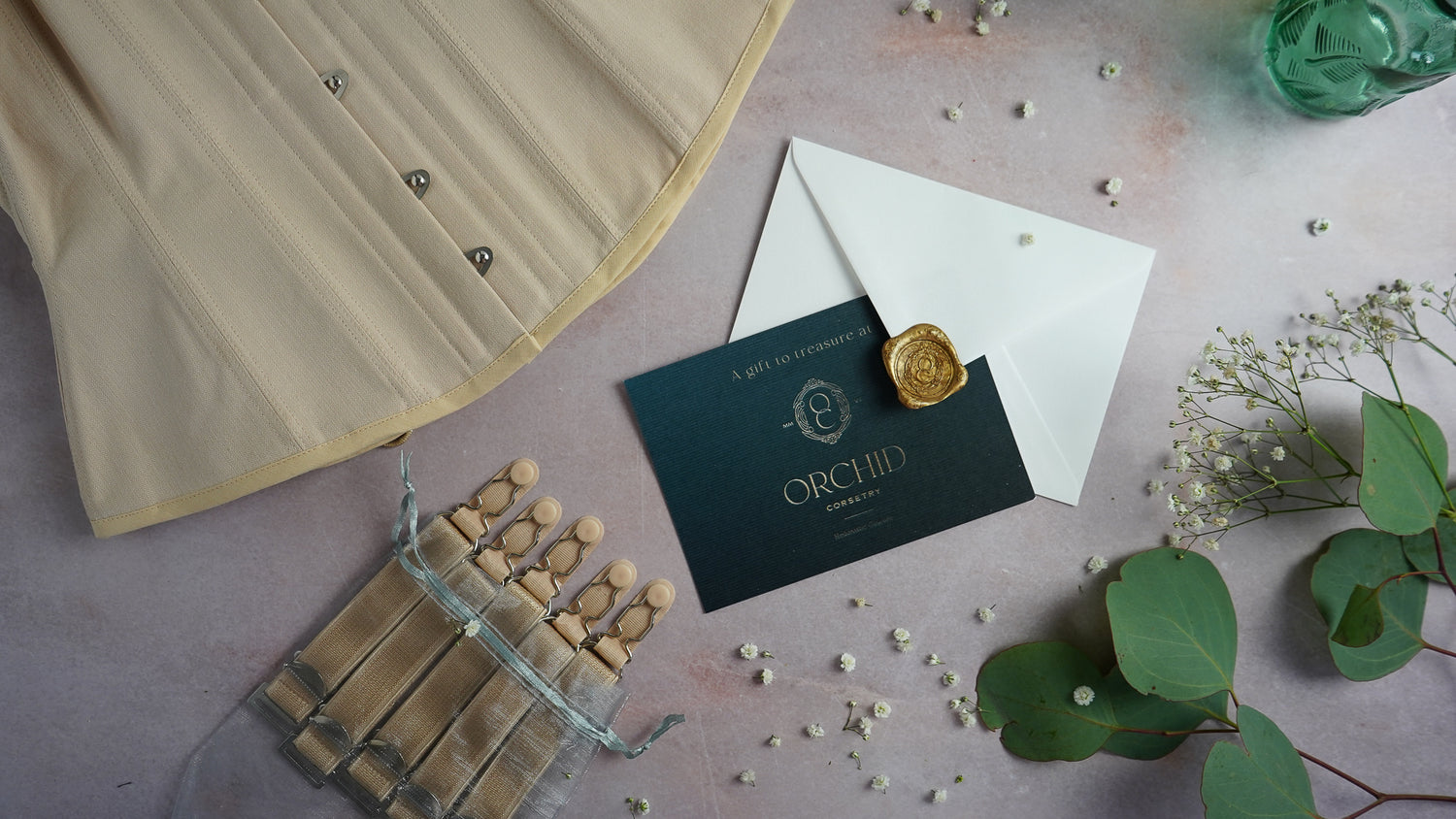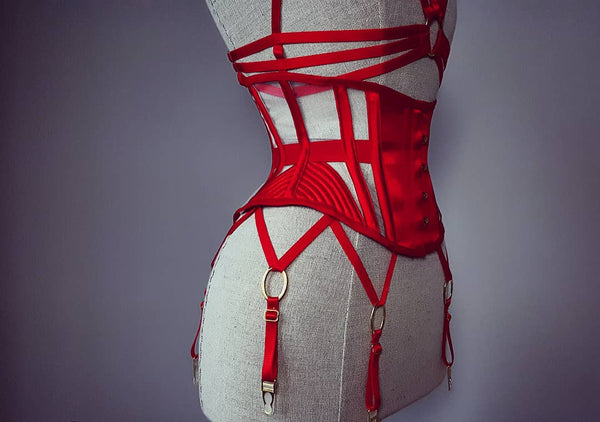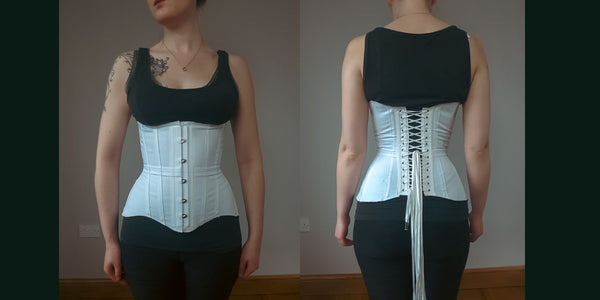
The Lingo
I hope to grow this into a little series, so to start us off what could be better than building up our vocabulary?! As beginners, nothing can make you feel excluded like people using words you don’t fully understand, so let’s call this your reference library for all things corset, or your babel fish if you like your geekery as I do.
If a word is in bold, it’s because it has a description in our list should you need to reference it!
Bespoke– If you’ve spent a little while on our site, you may have spotted that we have two different sorts of corset that we offer at two different prices. Bespoke and made to order. Bespoke is our more exclusive (and expensive) option, and it essentially means that all elements of the corset are chosen by you, and that it is made from a unique pattern built from a large number of your own measurements. There will likely be fittings and toiles to ensure comfort and a flattering fit. For beginner's first corset you may not feel this is necessary, but clients who waist train or take a significant waist reduction will quickly need to move onto this option! It’s an opportunity to create a deeply personal piece with levels of comfort that simply cannot be achieved any other way!

Boning – We still call the corset supports and the process of inserting them “boning” – even though it’s been many years since we stopped hunting whales for their precious baleen. Nowadays, if I talk about your corset boning I’m more than likely talking about flat and spiral steel, as illustrated below. Some people think that it’s boning that creates the waist reduction – but you can now correct them! Boning prevents the corset from wrinkling at the waist under the tension of tightlacing. It also gives support to the compressed body, and can play a part in adjusting your posture.
Busk – The busk is the front fastening you will come across on a lot of corsets in my shop. It consists of two steel bones, one of which has hooks riveted securely on, and the other has studs to meet them. The patent for the first busk was registered in 1829 and we have not altered it much! There are many different types but this is more than likely what is inside your corset. They make it much easier to get in and out of your corset on your own and as they come in a wide variety of colours and functional styles, they play a part in the beauty and support of your finished garment!

Corsetiere– This is the proper term for the person who makes your corsets! Corsetmaker is also fine, but doesn’t corsetiere feel nicer to say? If you want more of a glimpse into my job, here’s another blog post for you.

Cinch– You may hear about waist cinchers (a type of corset, usually intended for light waist reduction) or asked how much you “cinch” down by. This is effectively another term for waist reduction, or the action of reducing your waist!
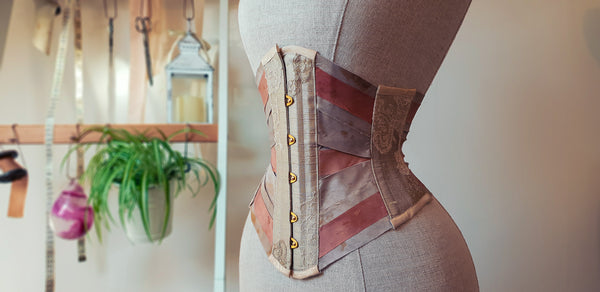
Eyelets – Technically, we use the higher quality “grommets” for the lacing section of our corsets, but eyelets is the better known term. These metal rings are set into the fabric to reinforce it sufficiently for us to reduce the waist and tighten the lacing time and time again. In earlier styles, hand embroidered eyelets were used until the metal eyelet was invented in 1828, meaning corsets could be laced tighter than ever before, without fear of tearing of the fabric.
Made To Order – This is where most beginners will start their corset wearing journey with us. These corsets are significantly cheaper than bespoke pieces because they are made to a standard size pattern, meaning they will fit most people pretty well! These corsets are a great way to test the waters, experiment with styling your corset and have some fun! Being made to order means these corsets are not sitting, waiting to be posted out to you – we give you lots of options for you to create your perfect “pick and mix” corset look and then make it once you’ve ordered it. This allows us flexibility if you have any special requests or need sizing on the pattern tweaked to work better for you!
Off The Rack – Also known as OTR or RTW (ready to wear) OTR corsets are made to a standard size pattern, sometimes mass-produced and ready to be popped through your letterbox! Again, these are a fun way for beginners to experiment with corsetry if you don’t have any specialist fit requirements.


Tightlacing – Here’s a useful term. Tightlacing is the insider word for wearing your corset, for me, it tends to infer that you wear your corsets regularly, but you do not waist train. However, the practice of waist training is really tightlacing daily with the intention of greater figure alteration!
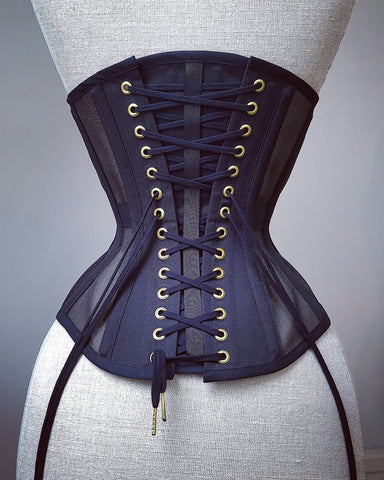
Toile – Pronounced “twarrrl“! If you’re having a bespoke corset, you will likely come across these! Essentially, a toile is your intended corset pattern made up in a basic fabric in order to test the fit, comfort and style in real life. A good friend of mine says that “measurements are a 2D version of a 3D reality” and she’s absolutely right! A toile lets us see where we need to develop and improve from what the tape measure told us. A toile will likely be very rough and simple to look at, but it is the key to unlocking a corset that feels like a second skin.
Training Corset – Generally speaking, a corset intended for waist training tends to be bespoke, as it needs to fit the wearer really well to be comfortable for long hours of daily wear. We will put a lot of thought into engineering it to be durable, suitable for the environment of the wearer (it may need to be used in a hot climate or worn discreetly to work) and ensuring it offers the right type of support for the amount of reduction being taken and any other requirements the wearer has. Training corsets can look very simple, but there’s a lot of knowledge and skill in bringing the right corset to the right wearer!
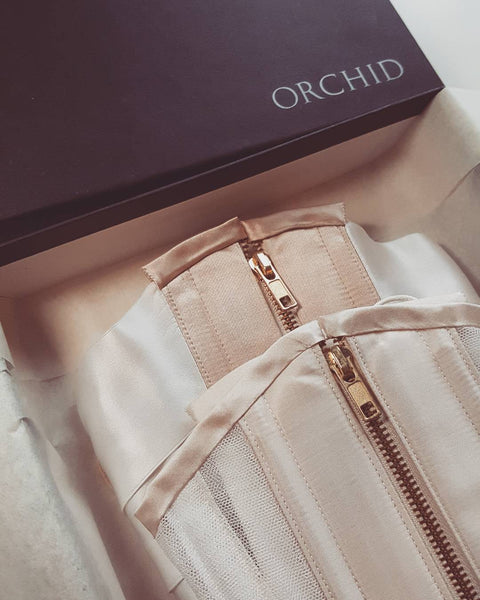
Waist Reduction – When you’re asked to calculate your waist reduction, we’re talking about what the corset is built to cinch you down by. For beginners buying their first corset this is more than likely to be 2-4″ or 5-10cm, but a lot of factors can alter this. Confused? We have a sneaky tip to help you find your ideal starter reduction – take your tape measure and note your natural waist measurement. Then slowly cinch down until it’s no longer comfortable for you (remember that your corset will distribute the pressure more evenly) this second measurement will indicate your potential corseted waist size!

Waist Training – You may have heard people talk about their waist training plans. The goal is to create semi-permanent figure modifications through wearing your corset consistently over time (see Tightlacing) Waist training means that you can slowly build up the hours you spend in your corset and subsequently wear a smaller waist size of corset. It is about patience, dedication and persistence. It’s not for overnight results or quick wins! But if you want to achieve a dramatic silhouette, this is the route to it. We sell starter waist training kits which are a great way to care for yourself while you embark on this process. Some beginners do go straight onto waist training, but for most it’s a more gradual approach!

Did we miss out a term you’re curious about? Let us know! We’ll be happy to add it. What would you like our next beginners article to focus on?
